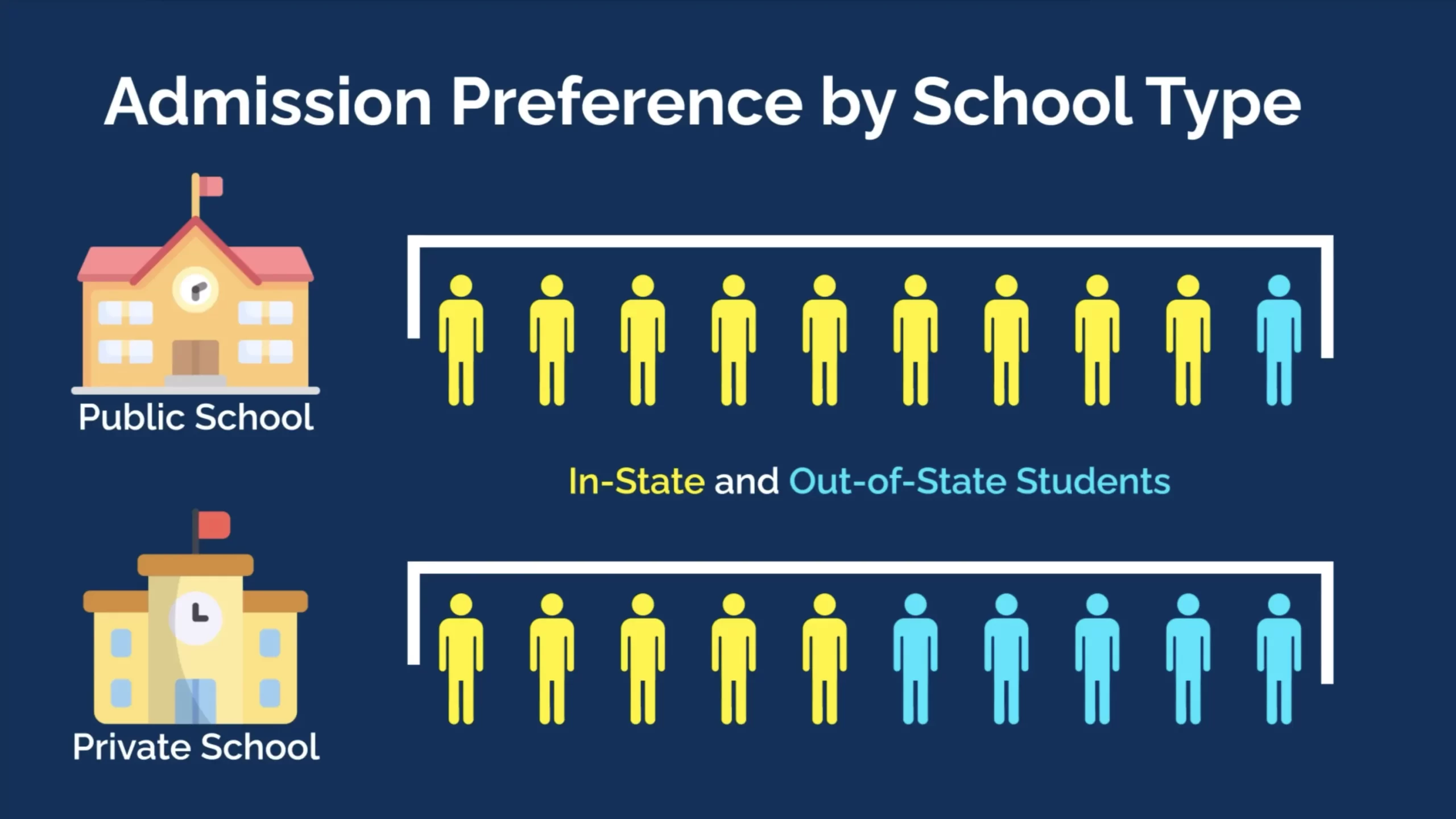
Why It’s Harder for Asians to Get Into Med School
Asian applicants need the highest MCAT & GPA of any group. This is what that means for Asian med school applicants.

Most medical school applicants are going to be applying out-of-state simply based on the number of medical schools you should apply to. If you’re applying to approximately 25 schools, which is what we recommend, you won’t be able to find all of those schools in one state. Even if you happen to be in one of those lucky states like California, New York, or Texas with 16, the reality is you’ll likely be applying out-of-state.
But every school is different; some cater almost exclusively to in-state students, whereas others encourage out-of-state applicants. It’s up to you to put in the research to determine which schools make the most sense to apply to based on acceptance data, school fit, and personal preferences.
So, what do you need to know about applying out-of-state, and how do you determine which schools are right for you?
In the guide, we cover the factors to consider when applying out-of-state, the pros and cons of in-state vs out-of-state, and how to choose the best medical school for you.
The bottom line is it’s very likely you will be applying to out-of-state schools. To cover target, reach, and safety schools, we recommend applying to approximately 20 different medical schools, and no state has this many.
If you’re concerned about the strength of your application or are a reapplicant, you should apply to more than 20 schools for your best chance of acceptance. Read our guide, which covers how many schools to apply to as well as how to balance target, reach, and safety schools: How Many Medical Schools Should I Apply to?
An exception exists if you live in Texas. Texas medical schools heavily favor in-state applicants, and tuition is much lower for residents. And since Texas uses its own application service, students may decide they only want to apply through TMDSAS (the Texas Medical and Dental School Application Service) rather than submit a second application through AMCAS, the main application service for US medical schools.
If you don’t live in Texas, your decision won’t be whether or not to apply out-of-state, but how many out-of-state schools to apply to and how far you’re willing to live from your family and friends.
Your first step in crafting a medical school list is to study the data provided by the Medical School Admission Requirements™ (MSAR®), an online database that allows you to search and compare information about medical schools in the US, Canada, and beyond. You can actually check how many in-state and out-of-state applicants schools accept each year, and it’s very easy to spot trends.
A good rule of thumb is state-funded medical schools usually prefer in-state applicants, whereas private schools don’t tend to have an in-state or out-of-state preference. For example, Harvard, Stanford, or Emory accept both in-state and out-of-state applicants in equal measure.

Some schools nearly exclusively prioritize in-state applicants, and in these cases, it can be a waste of your time to apply. That’s why it’s so important to deeply research each school you apply to.
Determine your risk preference for applying to out-of-state schools with a preference for in-state applicants.
You’re already at a disadvantage applying to medical school at all. Less than 50% of applicants earn medical school acceptance. You do not want to compound that by applying to mostly out-of-state schools that only accept 10-20% of out-of-state applicants.
While MSAR provides basic statistics, the Med School Insiders Chance Predictor offers more comprehensive insights. The Predictor compares your specific stats to comprehensive admissions data from all US medical schools.
Based on multiple factors, our tool determines where you’re most likely to be a strong fit. You’ll easily identify which out-of-state schools are most receptive to your application profile.
Instead of just raw statistics, you get personalized recommendations tailored to your profile, saving you time by focusing your application efforts on schools where you have the best chances.
Do you want to live in the state where the school is located? This is an extremely important consideration for a number of reasons, including whether or not you have a partner and how close you are with your friends and family. Long distance relationships can put quite a strain on both you and your partner, as well as friendships.
If you’ll be moving for medical school, how far are you willing to be from your home state? A three hour drive is much different than relocating to the other side of the country.
Plus, there’s the climate to consider. If you live in a southern state and don’t have many or any personal experiences with snow, you’re in for a chilly surprise. The novelty of a snowfall and below freezing weather can be very short-lived when you have to trudge through it every morning for your 8 am class.
There’s also moving fees and the cost of living to consider.

While the prospect of a big move may be intimidating, there is tremendous value in stepping outside of your comfort zone and getting comfortable with being uncomfortable. Medical school is a grueling experience that will challenge your resilience, social skills, time management, and intellect in ways they have not been challenged before.
Intentionally exposing yourself to the unfamiliar or potentially scary builds your resilience and expands your mind.
Playing it safe and sticking with the familiar does not help you grow as a medical student or as a person. As a practicing physician, you’ll be meeting new people every day. It’s important to start building your people skills, problem solving abilities, and independence early on, and a good way to do that is by moving to a completely different city and immersing yourself in all of the different sights, sounds, and smells that come with it.
Moving away from your family and the familiar might be scary at first, but that’s the whole point. You’re stepping outside of what’s comfortable and pushing your limits to build confidence, resilience, and inner strength.
Tuition and cost of living vary significantly from one state to the next and from one school to another. These are factors to keep in mind when planning, but these factors shouldn’t limit your school list initially.
Tuition for medical school will be expensive regardless of where you choose to study, but some schools are much more expensive than others. For example, the yearly tuition for out-of-state students at Baylor College of Medicine in Texas is $35,904, whereas the yearly tuition for out-of-state students at Stanford School of Medicine in California is nearly double that at $64,901.
If you live in Texas, it may be tough to turn down the lower cost of tuition available to you compared to the cost of out-of-state schools.
The cost of living also varies dramatically from state to state. For example, if you’re from Georgia and considering moving to New York for medical school, Georgia ranks 47th for cost of living by state, and New York ranks fifth. This means your everyday expenses will skyrocket, and that can be tough to sustain for four years of medical school.
That said, your financial aid options won’t be known until you secure an acceptance, so don’t avoid applying to a school you’re excited to attend based on costs alone. There are plenty of opportunities to gain financial aid and scholarships, especially if you are a competitive applicant.
For example, you can earn merit-based scholarships that completely cover the cost of tuition. This is what I did by leveraging multiple acceptances with a near-perfect GPA and MCAT score, as well as soft components like research, clinical experience, and hobbies.
Apply broadly and only assess your financial situation once you start receiving acceptances.

Every medical school has its own unique mission, priorities, and goals. A school’s values provide clues as to the kind of medical student the school is most interested in accepting. Admissions committees are on the lookout for the students who most closely align with their mission and values.
For example, does the school emphasize humanitarian efforts or scientific innovation, and, more importantly, which do you personally relate to more? If you’re turned off by or disinterested in a school’s mission, you likely won’t be happy there, which means you should search for schools that better align with your interests and own goals.
You will be asked directly and extensively why you are a good fit for a specific school in both your secondary essays and on the interview trail. Do you share the school’s values? When specifically in your life have you shown your commitment to those values? How do you plan on helping the school to accomplish its mission during your time there if you are accepted?
It’s up to you to convince the admissions committee that you both fully believe in and are committed to helping them advance their mission. This will be a challenge if you don’t actually believe in the school’s mission or align with its priorities.
Where the school is located is only one piece of the puzzle. If your dream school is across the country, making a huge life transition may be worthwhile and could be the experience of a lifetime.

Attending medical school in a different state comes with both pros and cons. On the con side, it means leaving your family and friends and the home you’ve likely known your entire life. If you have a partner, you’ll likely need to commit to a long distance relationship or break up. From a financial perspective, in-state medical schools are also cheaper to attend, and depending on which state you move to, your cost of living could increase as well.
But on the pro side, moving away from home is an adventure! It means meeting different people, interacting with diverse populations, and independence.
If independence, adventure, and expanding your comfort zone sound appealing, out-of-state medical schools may be an ideal fit for you. If, however, you believe you will require the support of having your friends and family nearby and med school in general sounds like enough of an adventure, you may want to stay closer to home.
You know yourself best, but remember that there’s a lot to gain from discomfort and stepping outside of what you know. It’s through pushing our limits that we learn and grow. You may not think you want to go to school far away from home, but it could be a transformative experience that helps shape you into the skilled and confident doctor you hope to become.
Prioritize finding and choosing a school that best aligns with your values, goals, and the type of medical school experience you want to have. These aspects will ultimately matter more than slight cost differences or a climate you’re unfamiliar with.
There are many different aspects to consider when choosing which medical schools to apply to, from the location to tuition costs to cost of living to school rank to teaching methods, and more. Start your research as soon as possible and give yourself all the time you can to research each program thoroughly—this includes visiting the city where the school is located to see if you would truly enjoy living there.
When crafting your list, use our comprehensive guide: How to Decide Which Medical Schools to Apply to (12 Important Factors).
Start your research as soon as possible and give yourself all the time you can to research each program thoroughly—for some this may even include visiting the city where the school is located to see if you would truly enjoy living there.
Take advantage of our free Medical School Chance Predictor to craft a personalized school list in minutes.

Asian applicants need the highest MCAT & GPA of any group. This is what that means for Asian med school applicants.

Learn what clinical rotations are required, how to order them, and how to make the most out of each medical school clerkship.